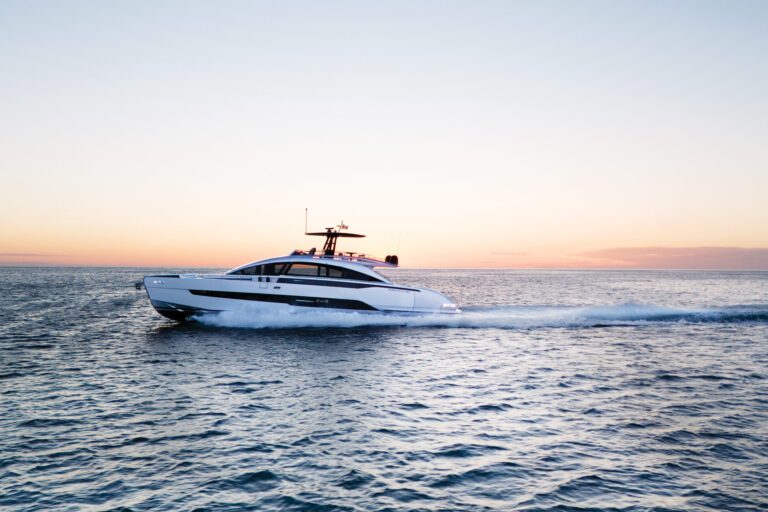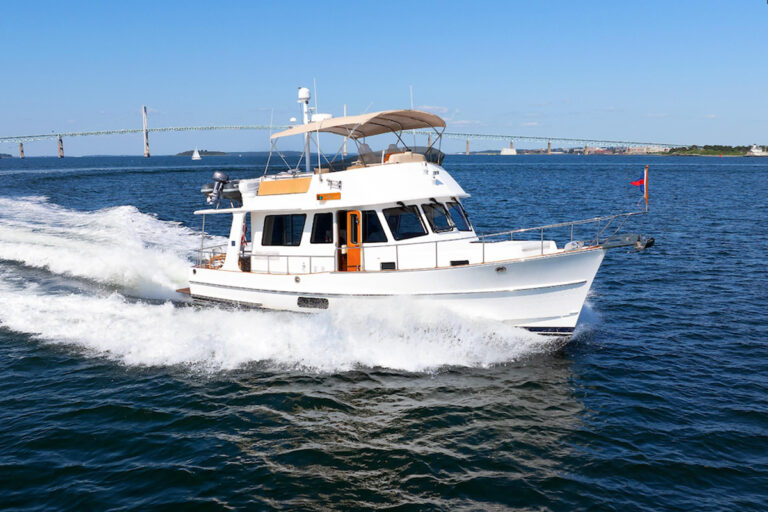
yachting/images/magazine/2007/032007/fea_sanlorenzo1_525x349.jpg
In the days when kings bestrode continents and aristocracy reigned, it wasn’t at all uncommon for a noble to bear a name as long as the lance he took to the annual joust-and you could be sure every vowel, every “und and “graf and “von meant something too. That’s why I paid particular attention to the news that a sort of royal marriage between yachts had finally produced an heir.
Though it wouldn’t faze a member of the Hohenzollern or Thurn und Taxis families, the new line of Viking Custom Yachts by Sanlorenzo is a mouthful, yet one that pretty well sums up the program-American specs and service with Italian style.
The yachts, including the first U.S. delivery, an 88-foot model we tested recently, are built in Italy by Sanlorenzo. They are sold and serviced in the U.S. by the well-known Viking Yacht family. Equally important, the yachts are custom-built to the requirements of each purchaser, and that includes much more than selecting the fabric colors.
Viking Yachts, of course, is a New Jersey builder of top-tier sportfishing boats. In the past, the company had built motoryachts of its own design, but more than a decade ago, began importing yachts from England, marketing them through a stand-alone division known as Viking Sport Cruisers, headed by Tom Carroll.
The line of tasteful midsize motoryachts, fully supported by Viking’s parts and service facilities, are not Americanized versions of British boats, but rather are built from scratch to fully American specifications laid down by Carroll and his team. The Viking Sport Cruisers program has been a great success, so much so that current owners seeking to move up beyond the Sport Cruiser range did not want to leave the Viking umbrella, therefore began pressing Carroll for bigger boats. Thus was born the Viking-Sanlorenzo marriage.
Carroll has learned a great deal from the Sport Cruiser program, and every bit of that has gone into making sure that custom yacht deliveries are as problem-free as possible for U.S. buyers. A major part of that, of course, is assuring that the inevitable service needs can be handled as quickly and efficiently as possible. I had first seen the SL 88 under construction in Italy, but she was docked at Viking’s facility in Riviera Beach, Fla., when I visited for my sea trial. As I walked through the boat, the evidence presented by equipment selections, brand names and labels would have indicated a domestic build had I not known otherwise. The craftsmen tending to final touch-ups and other details were
Viking employees, as comfortable working aboard this yacht as any of the Jersey-built fishing boats. That’s as it should be but, unfortunately, is not the case with all imported yachts.
The other half of the team, of course, is Sanlorenzo. The veteran builder of fiberglass yachts, founded in 1958, is located in Ameglia, south of Genoa near La Spezia on the Mediterranean coast, an area rich in yachtbuilding tradition. Sanlorenzo, under the leadership of Max Perotti, has undertaken a significant upgrading of the original facility and has also completed an expansion of a second facility in Viareggio to build larger metal yachts. Perotti was a top manager for many years at one of Italy’s two largest production boatbuilders and has brought about major improvements, both in product and procedures, at Sanlorenzo. He has also brought in some of the best talent in the industry to help him, including Antonio Santella, whose background at one of Italy’s top custom aluminum yachtbuilders will serve him well as head of Sanlorenzo’s Viareggio facility.
The SL 88 is a proven model that has been well accepted in Europe and was selected as the first American introduction as it lies at the center of the range of Sanlorenzo fiberglass planing boats. The line includes 62-foot, 72-foot, 82-foot and 100-foot models, as well as a 108-foot model that became the second U.S. introduction when it premiered at the Miami boat show in February. The current catalog of Sanlorenzo models also includes semi- displacement fiberglass yachts at 92 and 122 feet, semi-displacement steel and aluminum yachts of 151 and 173 feet, and planing aluminum yachts of 125 and 138 feet.
While the sun shone brightly the day of our sea trial, the waters off Palm Beach showed the angry remnants of the storms that had blown through the area for several days prior to my visit. The forecast predicted two- to four-foot seas, but once we cleared the inlet, it was apparent that someone at the National Weather Service had badly missed the mark. We slogged on into steady four- to six-footers, with the occasional eight-footer sending spray through the bow chocks and onto the flying bridge.
The SL 88 was scheduled to get stabilizers, but they weren’t fitted yet, so a good measure of rolling combined with the pitching to make for a ride that was less than ideal. The Viking crew gets points for their willingness to sacrifice crew comfort in the name of journalistic integrity, but once the wine locker launched its full load of glass bottles onto the deck in the starboard passageway, the attempt at gathering speed/rpm data was abandoned in favor of a more sensible approach. We would use data gathered earlier by the Viking engineering team and took just a couple of readings ourselves, which we cross-checked to confirm the validity of Viking’s data.
Once that decision was made, we altered course to a more comfortable heading to get a qualitative feel for the SL 88’s seakeeping performance. At 23 feet of beam, she rides on a wide hull with full forward sections. That gives her lots of interior volume-in fact she’s one of the most spacious yachts I’ve seen at this length-but it makes a more pronounced reaction to the sea inevitable. The stabilizers will help with the rolling, but she will never be at her most comfortable in a head sea. To be fair, though, I must note that save for a lone sportfisherman just north of us, we were the only pleasure boat to venture out that morning.
That voluminous interior carries four guest staterooms belowdecks, reached via a stairway from the starboard entry foyer. The full-beam master, adjacent to the engineroom, has a king berth and a spacious head with whirlpool tub and separate toilet compartment. Flanking the bed are a vanity to starboard and dressers to port; a large walk-in closet completes the suite. Forward is a full-beam VIP stateroom that rivals the master in space and appointments. There are two additional guest staterooms, the starboard with a queen berth and the port with twins. The inboard twin berth is raised to allow space beneath for a washer and dryer, accessible from the passageway, and a short hanging locker in the stateroom. Both staterooms have en suite heads. There are also two crew cabins forward, accessed by a separate stairway from the galley.
The master and guest staterooms benefit from large oval ports, oriented vertically, that offer lots of light and a fantastic view of the sea. They are softened by sheer Roman shades, and for total privacy, electric blackout curtains can be closed behind them at the touch of a button. This design feature was introduced by Carroll and his Viking team, but may well be adopted by Sanlorenzo for their European deliveries as well.
The galley stops short of being a country-kitchen arrangement but does include a dinette that will seat five to seven crew or guests; it is raised for a view through the side windows to port. The dining room is just aft, divided from the saloon by a low cabinet that houses fitted stowage for the crystal. Joinery throughout the SL 88 is African cherry with a high-gloss finish for the casual look; the SL 108 has mahogany with a semi-gloss finish to create a more formal atmosphere.
The builder’s attention to detail is impressive, particularly in a boat of this length, and I often had the impression I was on a much larger yacht. The saloon sole is covered in a white berber carpet, the dining room with white marble, and both were nicely edged with inlaid wood that followed the gentle curve of the peripheral cabinetry. Air-conditioning intakes were hidden in the toekicks and outlets were tucked behind the curtain valances. The pattern of the cabinetry was mirrored in the molding of the overhead. Though sometimes found on larger custom yachts, such intricacies are rare on 88-footers.
The flying bridge can be reached through the raised pilothouse or via an outside stairway, complete with door, from the aft deck. Four individual Stidd helm seats lie forward, with a dinette seating four to six guests and a bar seating three completing the deck. The entire area is shaded by a hardtop that, in profile, appears cantilevered from the aft wingboards, but should sunning be desired, a large convertible panel in the hardtop opens electrically.
Our test boat was propelled by two Cat C32A diesels, but MTU engines are available as an option. The engines sat aft, powering V-drive gears through isolation couplings. Moderate propeller tunnels were molded into the hull bottom to reduce draft, and transom mounted intruders worked in conjunction with active tabs to control running trim.
Contact: Viking Custom Yachts; www.vikingcustomyachts.com Sanlorenzo; www.vikingcustomyachts.com





